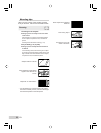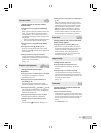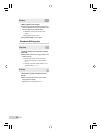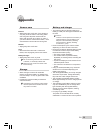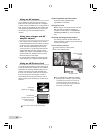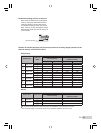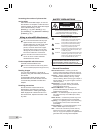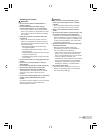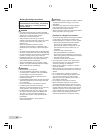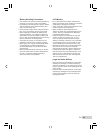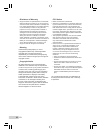
64
EN
Battery Handling Precautions
Follow these important guidelines to
prevent batteries from leaking, overheating,
burning, exploding, or causing electrical
shocks or burns.
DANGER
The camera uses a lithium ion battery specifi ed
by Olympus. Charge the battery with the specifi ed
charger. Do not use any other chargers.
Never heat or incinerate batteries.
Take precautions when carrying or storing
batteries to prevent them from coming into contact
with any metal objects such as jewelry, pins,
fasteners, etc.
Never store batteries where they will be
exposed to direct sunlight, or subjected to high
temperatures in a hot vehicle, near a heat source,
etc.
To prevent causing battery leaks or damaging their
terminals, carefully follow all instructions regarding
the use of batteries. Never attempt to disassemble
a battery or modify it in any way, solder, etc.
If battery fl uid gets into your eyes, fl ush your eyes
immediately with clear, cold running water and
seek medical attention immediately.
Always store batteries out of the reach of small
children. If a child accidentally swallows a battery,
seek medical attention immediately.
WARNING
Keep batteries dry at all times.
To prevent batteries from leaking, overheating,
or causing a fi re or explosion, use only batteries
recommended for use with this product.
Insert the battery carefully as described in the
operating instructions.
If rechargeable batteries have not been recharged
within the specifi ed time, stop charging them and
do not use them.
Do not use a battery if it is cracked or broken.
If a battery leaks, becomes discolored or
deformed, or becomes abnormal in any other way
during operation, stop using the camera.
If a battery leaks fl uid onto your clothing or skin,
remove the clothing and fl ush the affected area
with clean, running cold water immediately. If
the fl uid burns your skin, seek medical attention
immediately.
Never subject batteries to strong shocks or
continuous vibration.
•
•
•
•
•
•
•
•
•
•
•
•
•
•
•
•
CAUTION
Before loading, always inspect the battery carefully
for leaks, discoloration, warping, or any other
abnormality.
The battery may become hot during prolonged
use. To avoid minor burns, do not remove it
immediately after using the camera.
Always unload the battery from the camera before
storing the camera for a long period.
Caution for Usage Environment
To protect the high-precision technology contained
in this product, never leave the camera in the
places listed below, no matter if in use or storage:
Places where temperatures and/or humidity
are high or go through extreme changes.
Direct sunlight, beaches, locked cars, or near
other heat sources (stove, radiator, etc.) or
humidifi ers.
In sandy or dusty environments.
Near fl ammable items or explosives.
In wet places, such as bathrooms or in the rain.
When using products with weatherproof designs,
read their manuals as well.
In places prone to strong vibrations.
Do not get water or sand on the camera when
using it at the beach or in sandy places as this
may lead to damage or malfunction.
Never drop the camera or subject it to severe
shocks or vibrations.
When mounted on a tripod, adjust the position of
the camera with the tripod head. Do not twist the
camera.
Do not touch electric contacts on cameras.
Do not leave the camera pointed directly at the
sun. This may cause lens or shutter curtain
damage, color failure, ghosting on the CCD, or
may possibly cause fi res.
Do not push or pull severely on the lens.
Before storing the camera for a long period,
remove the batteries. Select a cool, dry location
for storage to prevent condensation or mold from
forming inside the camera. After storage, test the
camera by turning it on and pressing the shutter
button to make sure that it is operating normally.
Always observe the operating environment
restrictions described in the camera’s manual.
•
•
•
•
•
•
•
•
•
•
•
•
•
•
•
•
•



